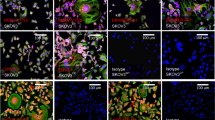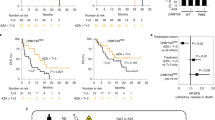Abstract
Following transduction with a retrovirus (SF1MIH) expressing both the multidrug resistance 1 (MDR1) and O6-alkylguanine-DNA-alkyltransferase (ATase) proteins, human erythroleukaemic progenitor (K562) cells were isolated which were resistant to killing by the MDR1 substrate, colchicine. In colony-forming survival assays, K562-SF1MIH cells exhibited resistance to colchicine and doxorubicin, as well as to the O6-alkylating agents N-Methyl-N-nitrosourea (MNU) and temozolomide. Furthermore, the resistance to doxorubicin was abolished by preincubation with the MDR1 inhibitor verapamil while resistance to MNU was ablated by the specific ATase inactivator, O6-benzylguanine (O6-beG) confirming that resistance to doxorubicin and MNU was conferred by MDR1 and ATase, respectively. When K562-SF1MIH were exposed to combinations of colchicine and MNU or doxorubicin and temozolomide, simultaneous resistance to these agents was observed. Thus, transduction of K562 with SF1MIH conferred dual resistance to these cells. These data offer the prospect of designing vectors that will confer resistance to entire regimens of chemotherapy rather than just to individual components of such drug cocktails, thereby substantially increasing the efficacy of therapy. Furthermore, the use of such dual expression constructs is likely to be highly informative for the design of effective in vivo selection protocols, an issue likely to make a major impact in a clinical context in gene therapy in the near future.
This is a preview of subscription content, access via your institution
Access options
Subscribe to this journal
Receive 12 print issues and online access
$259.00 per year
only $21.58 per issue
Buy this article
- Purchase on Springer Link
- Instant access to full article PDF
Prices may be subject to local taxes which are calculated during checkout



Similar content being viewed by others
References
Mauch P et al. Hematopoietic stem cell compartment: acute and late effects of radiation therapy and chemotherapy Int J Radiat Oncol Biol Phys 1995 31: 1319–1339
O’Driscoll BR et al. Active lung fibrosis up to 17 years after chemotherapy with carmustine (BCNU) in childhood New Engl J Med 1990 323: 378–382
Smith MA, McCaffrey RP, Karp JE . The secondary leukemias: challenges and research directions J Natl Cancer Inst 1996 88: 407–418
Gottesman MM, Pastan I . Biochemistry of multidrug resistance mediated by the multidrug transporter Annu Rev Biochem 1993 62: 385–427
Banerjee D et al. Gene therapy utilizing drug resistance genes: a review Stem Cells (Dayt) 1994 12: 378–385
Sorrentino BP, McDonagh KT, Woods D, Orlic D . Expression of retroviral vectors containing the human multidrug resistance 1 cDNA in hematopoietic cells of transplanted mice Blood 1995 86: 491–501
Moritz T et al. Retrovirus-mediated expression of a DNA repair protein in bone marrow protects hematopoietic cells from nitrosourea-induced toxicity in vitro and in vivo Cancer Res 1995 55: 2608–2614
Baum C et al. Gene transfer to augment the therapeutic index of anticancer chemotherapy Gene Therapy 1996 3: 1–3
Rafferty JA et al. Chemoprotection of normal tissues by transfer of drug resistance genes Cancer Metastasis Rev 1996 15: 365–383
Allay JA, Davis BM, Gerson SL . Human alkyltransferase-transduced murine myeloid progenitors are enriched in vivo by BCNU treatment of transplanted mice Exp Hematol 1997 25: 1069–1076
Chinnasamy N et al. Chemoprotective gene transfer II: multilineage in vivo protection of haemopoiesis against the effects of an antitumour agent by expression of a mutant human O6-alkylguanine-DNA alkyltransferase Gene Therapy 1998 5: 842–847
Hickson I et al. Chemoprotective gene transfer I: transduction of human haemopoietic progenitors with O6-benzylguanine-resistant O6-alkylguanine-DNA alkyltransferase attenuates the toxic effects of O6-alkylating agents in vitro Gene Therapy 1998 5: 835–841
Ward M et al. Transfer and expression of the human multiple drug resistance gene in human CD34+ cells Blood 1994 84: 1408–1414
Baum C et al. Novel retroviral vectors for efficient expression of the multidrug resistance (mdr-1) gene in early hematopoietic cells J Virol 1995 69: 7541–7547
Hanania EG et al. Resistance to taxol chemotherapy produced in mouse marrow cells by safety-modified retroviruses containing a human MDR-1 transcription unit Gene Therapy 1995 2: 279–284
Eckert HG et al. High-dose multidrug resistance in primary human hematopoietic progenitor cells transduced with optimized retroviral vectors Blood 1996 88: 3407–3415
Hanania EG et al. Results of MDR-1 vector modification trial indicate that granulocyte/macrophage colony-forming unit cells do not contribute to posttransplant hematopoietic recovery following intensive systemic therapy Proc Natl Acad Sci USA 1996 93: 15346–15351
Hesdorffer C et al. Phase I trial of retroviral-mediated transfer of the human MDR1 gene as marrow chemoprotection in patients undergoing high-dose chemotherapy and autologous stem-cell transplantation J Clin Oncol 1998 16: 165–172
Harris LC et al. Retroviral transfer of a bacterial alkyltransferase gene into murine bone marrow protects against chloroethylnitrosourea cytotoxicity Clin Cancer Res 1996 1: 1359–1368
Jelinek J et al. Long-term protection of hematopoiesis against the cytotoxic effects of multiple doses of nitrosourea by retrovirus-mediated expression of human O6-alkylguanine-DNA-alkyltransferase Blood 1996 87: 1957–1961
Maze R et al. Increasing DNA repair methyltransferase levels via bone marrow stem cell transduction rescues mice from the toxic effects of 1,3-bis(2-chloroethyl)-1-nitrosourea, a chemotherapeutic alkylating agent Proc Natl Acad Sci USA 1996 93: 206–210
Reese JS et al. Retroviral transduction of a mutant methylguanine DNA methyltransferase gene into human CD34 cells confers resistance to O6-benzylguanine plus 1,3-bis(2-chloroethyl)-1-nitrosourea Proc Natl Acad Sci USA 1996 93: 14088–14093
Hildinger M et al. Dominant selection of hematopoietic progenitor cells with retroviral MDR1 co-expression vectors Hum Gene Ther 1998 9: 33–42
Hickson I et al. Protection of mammalian cells against chloroethylating agent toxicity by an O6-benzylguanine-resistant mutant of human O6-alkylguanine-DNA alkyltransferase Gene Therapy 1996 3: 868–877
Dunbar C, Young NS . Gene marking and gene therapy directed at primary hematopoietic cells Curr Opin Hematol 1996 3: 430–437
Davis BM et al. Selection for G156A O6-methylguanine DNA methyltransferase gene-transduced hematopoietic progenitors and protection from lethality in mice treated with O6-benzylguanine and 1,3-bis(2-chloroethyl)-1-nitrosourea Cancer Res 1997 57: 5093–5099
Rafferty JA et al. Site-directed mutagenesis of glutamic acid 172 to glutamine completely inactivated human O6-alkylguanine-DNA-alkyltransferase Biochem Biophys Res Commun 1994 199: 285–291
Bunting KD et al. Transduction of murine bone marrow cells with an MDR-1 vector enables ex vivo stem cell expansion, but these expanded grafts cause a myeloproliferative syndrome in transplanted mice Blood 1998 92: 2269–2279
Acknowledgements
JJ and RC were supported by grant 3557–3 from the Internal Grant Agency, Ministry of Health, Czech Republic. JAR, LJF, GPM and TMD were supported by grants from the Medical Research Council and the Cancer Research Campaign. MH was supported by the German José-Carreras-Leukemia-Fond, CB by the Deutsche Krebshilfe (10–1063-BaI). Our thanks to Gill Foster for provision of technical assistance with aspects of immunocytochemistry and to Eva Mikulova and Eva Podzimkova for cell culture work.
Author information
Authors and Affiliations
Rights and permissions
About this article
Cite this article
Jelinek, J., Rafferty, J., Cmejla, R. et al. A novel dual function retrovirus expressing multidrug resistance 1 and O6-alkylguanine-DNA-alkyltransferase for engineering resistance of haemopoietic progenitor cells to multiple chemotherapeutic agents. Gene Ther 6, 1489–1493 (1999). https://doi.org/10.1038/sj.gt.3300962
Received:
Accepted:
Published:
Issue Date:
DOI: https://doi.org/10.1038/sj.gt.3300962
Keywords
This article is cited by
-
Pharmacogenetics of ATP binding cassette transporter MDR1(1236C>T) gene polymorphism with glioma patients receiving Temozolomide-based chemoradiation therapy in Indian population
The Pharmacogenomics Journal (2021)
-
Epigenetic synergy between decitabine and platinum derivatives
Clinical Epigenetics (2015)
-
Chemoprotection of murine hematopoietic cells by combined gene transfer of cytidine deaminase (CDD) and multidrug resistance 1 gene (MDR1)
Journal of Experimental & Clinical Cancer Research (2015)
-
F2A sequence linking MGMTP140K and MDR1 in a bicistronic lentiviral vector enables efficient chemoprotection of haematopoietic stem cells
Cancer Gene Therapy (2012)
-
Gene therapy with drug resistance genes
Cancer Gene Therapy (2006)



